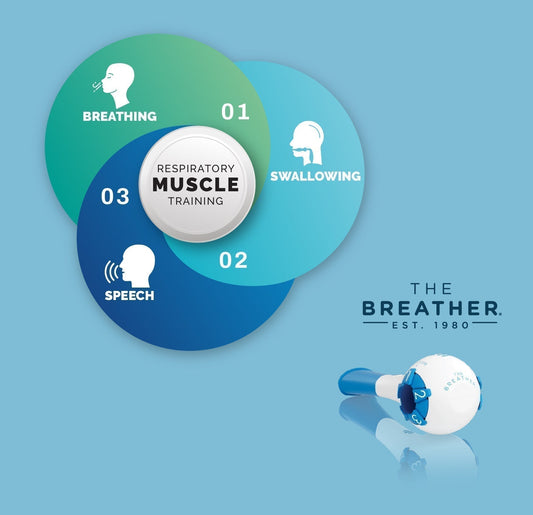Healthcare professionals are the backbone of any medical crisis, and during the COVID-19 pandemic, their role became even more demanding and stressful. Long hours, emotional exhaustion, and the fear of infection created a perfect storm for burnout.
According to the Centers for Disease Control and Prevention (CDC), in 2022, 46% of U.S. health workers reported feeling burned out often or very often, a significant increase from 32% in 2018. A meta-analysis from Frontiers in Psychiatry reported that the prevalence of burnout was about 52% in healthcare professionals during COVID-19 [1].
Beyond that, a 2023 study analyzed about 1.8 million working adults in the US from 2008 to 2019 and found that health care workers had a higher suicide rate compared to non-health care workers [2].
But what if a simple, portable breathing device could help reduce that stress?


In a recent study, researchers developed a Stress Resilience Program (SRP) specifically for healthcare professionals and integrated a respiratory muscle training device called BREATHER FIT.
The goal was to empower medical staff with tools to strengthen their lungs and stress response system. This innovative approach combined science-backed breathing techniques with education on resilience, and the results were promising.
In this article, we break down the study and explore how breathing training can become a game-changer in stress relief for caregivers.
A crisis within a crisis: The healthcare worker burnout
Burnout is no longer just a buzzword - it's a healthcare emergency. Even before the pandemic, stress and burnout were rampant in the healthcare industry. The high-stakes nature of the job, life-and-death decisions, emotionally charged environments, and long shifts took a heavy toll on mental and physical well-being.
Then COVID-19 hit, and the pressure intensified exponentially.
According to a 2024 survey by the American Medical Association, approximately 45.2% of US physicians reported experiencing burnout, with more than half citing emotional exhaustion and high stress as significant challenges [3]. Nurses, doctors, respiratory therapists, and hospital staff found themselves on the frontlines of an unrelenting crisis, often without adequate support or resources.


This level of sustained stress doesn’t just affect personal well-being; it leads to poorer patient outcomes, increased medical errors, and a rapid exodus from the workforce.
Traditional approaches, such as counseling, time off, or medication, aren’t always accessible. That’s where the idea of a simple, accessible, and non-pharmacological stress reduction tool becomes so essential. The SRP introduced in the recent study aimed to explore exactly that, providing healthcare workers with a scientifically grounded and practical approach to managing stress through the power of breathing.
A new hope: What is the stress resilience program (SRP)?
With healthcare workers stretched to their limits, researchers recognized the urgent need for a practical solution, something that could be easily implemented. That’s how the Stress Resilience Program (SRP) was born.
Developed as a pilot initiative, the SRP was a four-week intervention with two core components.
-
Educational sessions on resilience-building techniques
-
Daily breathing exercises using a device called BREATHER FIT


Participants also practiced “situational breathing” strategies, quick, guided breathwork that could be used in high-stress moments throughout their shifts.
Inside the study: How did we test the SRP?
To evaluate the effectiveness of RMT using BREATHER FIT within a structured stress resilience program, researchers conducted a four-week clinical study involving 10 healthy healthcare professionals from a large health care facility in Minnesota, United States [4].
These individuals, who were regularly exposed to high levels of occupational stress, represented a population at high risk for burnout and emotional exhaustion.
Participants received the full SRP, including situational breathing strategies and breathing exercises with BREATHER FIT. They also received an Oura Ring for an overview of their health parameters.
The goal was to compare perceived stress levels before and after the program and determine whether integrating RMT could offer measurable relief from stress.


The breathing protocol was using BREATHER FIT twice daily, completing two sets of 10 breaths per session. The BREATHER FIT sessions, as well as the situational breathing strategies, were guided by the Breather Coach app.
To assess changes in stress, researchers used the Perceived Stress Scale (PSS-10), a validated tool designed to measure an individual’s self-reported stress levels. The scale was administered at the beginning and conclusion of the four-week program, allowing researchers to track progress and determine the program’s effectiveness.
What the study found
Over four weeks, the researchers found excellent results. Let's break them down.
Stress reduction
The healthcare professionals who participated in the SRP experienced an 18% reduction (from 17.9 to 14.7) in perceived stress levels compared to the baseline.
User satisfaction
What’s especially promising is how well the intervention was received, as 80% of the participants liked the experience and showed intention to repeat the process.
Moreover, 90% of participants said they would recommend the program to colleagues, and many reported feeling more equipped to handle stress on the job.
No side effects
Even more encouraging, there were no adverse effects, proving that this breathing-based approach is not only effective but also safe and scalable.


This study reinforces a growing body of evidence suggesting that targeted breathing interventions can play a powerful role in stress management. But beyond the numbers, the real takeaway is clear: frontline workers were given a simple tool that made them feel better, stronger, and more in control.
That brings us to the bigger picture, which is why breathing is becoming such a hot topic in stress relief.
BREATHER FIT: The science behind the breathing device
At first glance, BREATHER FIT may seem like a simple tool, but its design and function are rooted in science that directly targets how the body responds to stress. This compact, hand-held device is built for combined Inspiratory and Expiratory Muscle Training (IMT/EMT), which means it provides resistance as you breathe in and out.
Doing so strengthens key respiratory muscles, leading to better lung function, improved oxygen intake, and more efficient overall breathing.


When we’re under pressure, our breathing becomes shallow and erratic, triggering the sympathetic nervous system, which governs our fight-or-flight response. This can lead to a cascade of stress-related symptoms: increased heart rate, tension, fatigue, and impaired focus.
BREATHER FIT helps retrain the body’s breathing patterns, promoting slower, deeper, and more controlled breaths that activate the parasympathetic nervous system, our built-in calming mechanism.
Over time, this training helps reduce heart rate and increases heart rate variability (HRV), a critical biomarker of how well the body can adapt to stress.
Why these findings matter
What makes this study groundbreaking is its practicality and scalability. Healthcare workers, athletes, educators, parents, and anyone experiencing chronic stress could benefit from structured breathing.
BREATHER FIT is portable, drug-free, and time-efficient, making it ideal for those with demanding schedules. Plus, it doesn’t require a clinical setting or therapist, allowing users to take control of their well-being independently.


Given the ever-rising rates of burnout across industries, this intervention could become a cornerstone in the broader landscape of stress management and mental health care.
Why are breathing-based interventions gaining ground?
Breathing is something we all do, but few of us do it optimally. In recent years, breathing techniques have taken center stage in wellness and performance science, from elite sports to trauma recovery. The reason is simple: how we breathe directly affects our nervous system, cardiovascular health, and mental clarity.
Unlike other stress-relief methods that may require time off, therapy, or medication, breathing interventions are portable, cost-effective, and immediately accessible. This approach is particularly useful for high-stress professionals who require rapid results and can’t afford downtime.
Conclusion
This study shows that breathing isn’t just essential for survival; it can be revolutionary for healing. By integrating BREATHER FIT into a structured program like SRP, healthcare workers experienced significant reductions in stress, improved resilience, and better control over their well-being.
In a world where stress is unavoidable, finding ways to train the body to respond better may be the key to long-term health. Whether you're on the frontlines or simply navigating the pressures of daily life, a few minutes of focused breathwork may help you reclaim your calm.
Frequently Asked Questions (FAQs)
-
How does BREATHER FIT help relieve stress in healthcare workers?
It supports stress relief by strengthening the breathing muscles through resistance training. This activates the parasympathetic nervous system (the “rest and digest” system), helping to calm the body and reduce stress.
-
Is breathing training practical for burnout and emotional fatigue?
Yes, breathing training has been shown to improve emotional resilience and reduce burnout symptoms. By training respiratory muscles and slowing the breath, users can lower heart rate variability and improve vagal tone, both strong indicators of improved stress response.
-
Can I use BREATHER FIT even if I don’t have a lung condition?
Absolutely. While BREATHER FIT is often used by people with respiratory issues or athletes looking to boost performance, it’s also ideal for healthy individuals under stress.
-
What makes BREATHER FIT different from meditation or mindfulness apps?
Unlike apps or techniques that require mental focus or a quiet setting, BREATHER FIT works through physical conditioning. It doesn’t rely on mindset or mood; it retrains your body’s response to stress by enhancing breathing strength and autonomic control. That’s why it benefits frontline workers who may not have time or space for traditional mindfulness practices.
-
Is this stress resilience program only for healthcare workers?
While the pilot study focused on healthcare professionals, the techniques and benefits of breathing training can be applied to anyone experiencing chronic stress or burnout.
-
How long does it take to see results?
In the study, participants saw significant stress reduction within just four weeks. Regular practice is key to gaining and maintaining results.
References
[1]. A Systematic Review and Meta-Analysis of Burnout Among Healthcare Workers During COVID-19
[2]. Suicide Risks of Health Care Workers in the US
[4]. Stress Resilience Program for Health Care Professionals During a Pandemic: A Pilot Program









